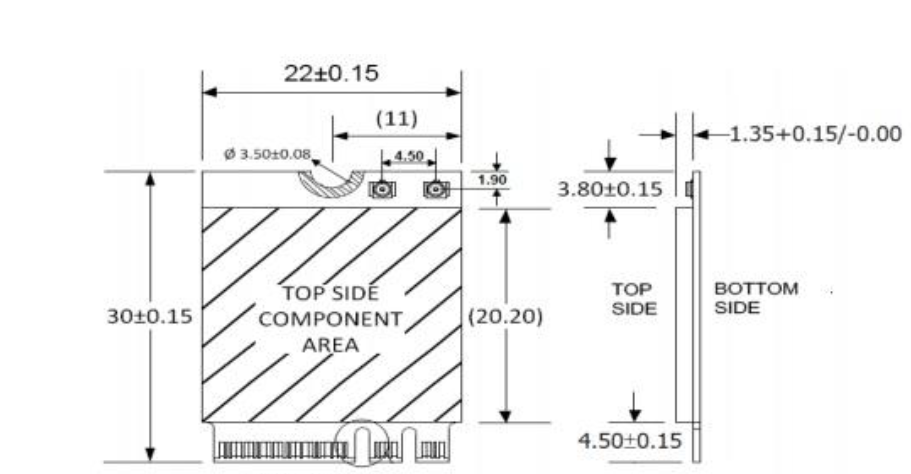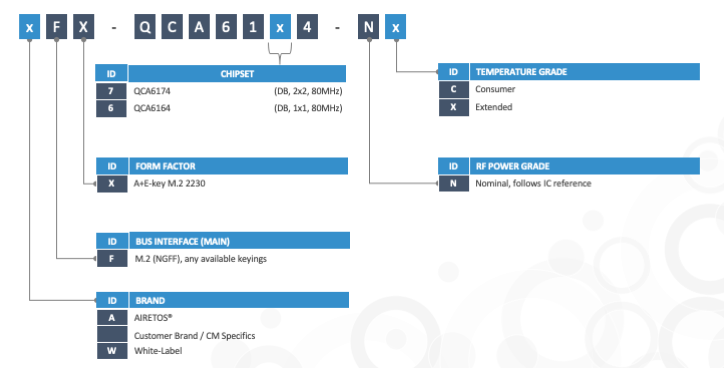SOLUTION DESIGN
Chipset: Qualcomm-Atheros QCA6174A-5; optional use of the QCA6164A-5 and QCA6574A.
Standard: IEEE 802.11 a/b/g/n/ac Wi-Fi, Bluetooth 5.0 with BLE and ANT+, backwards compatible with BT4.x, BT3.x+HS, BT2.x+EDR
Industrial Reference: Follows Qualcomm Atheros reference design NFA364A
APPEARANCE
Communications Interface:
Pads at edge connector:
WLAN: PCI Express Standard 2.1 host I/O
Bluetooth: via USB 1.1 with connections mapped to assigned PCIE PINs
Form Factor:
Slotted, Socketed
M.2 / NGFF (New Generation Form Factor), 2230 (22mm x 30mm) – Small size card
ANTENNA
Configuration:
WLAN: Two Spatial Streams (2 chains), 2x2, 2 Connectors, MU-MIMO Wave2
Client Compliant with Interference Suppression
Type:
Two on board HSC / IPEX (IPX) MHF4 receptacle coaxial connectors: Rx/Tx with WLAN and BT co-existence
WIRELESS PARAMETERS
Frequency Band:
WLAN:
2.4 GHz ISM Bands 2.412-2.472 GHz, 2.484 GHz
5.15-5.25 GHz (FCC UNII-low band) for US/Canada, Japan and Europe 5.25-5.35 GHz (FCC UNII-middle band) for US/Canada and Europe 5.47- 5.725 GHz for Europe
5.725-5.825 GHz (FCC UNII-high band) for US/Canada
* 4.9 Ghz bands are supported; calibration on request.
BT: 2402MHz~2483MHz
Data Transfer Rates:
WLAN 2.4GHz:
11n: Up to 150Mbps (PHY dynamic)
11g: Up to 54Mbps (PHY dynamic)
11b: Up to 11Mbps (PHY dynamic)
WLAN 5GHz:
11ac: Up to 867Mbps (PHY dynamic) (UDP 362, TCP 304)
11n: Up to 150Mbps (PHY dynamic)
11a: Up to 54Mbps (PHY dynamic)
BT: 1 Mbps, 2Mbps and Up to 3Mbps EDR)
Media Access Control: CSMA/CA with ACK
Channel:
22.4GHz: 1-13 (14 only for Japan)
5GHz: 36-48 149-165
Ultra-Fast Channel Switch (FTS): 100us within and 150us across bands Optimized Multi-channel concurrency
Bandwidth Support: 5Mhz, 10Mhz, 20Mhz 40Mhz, 80Mhz
Channel Spacing: 5MHz
Spreading / Modulation:
WLAN:
802.11ac/g/n: OFDM (BPSK, QPSK,16-QAM,64-QAM,256-QAM)
802.11b: CCK (11, 5.5Mbps), DQPSK (2Mbps), DBPSK (1Mbps)
BT: Header GFSK, Payload 2M: 4-DQPSK, Payload 3M: 8DPSK
RF Output Power:
802.11a 15.5 dBm at 54M +- 2dBm
802.11b: 18 dBm at 11M +/- 2 dBm
802.11g: 15.5 dBm at 54M +- 2dBm
8802.11n 5G HT20 : 17 dBm at MCS0 / 15 dBm at MCS7 +/- 2dBm
802.11n 5G HT40 : 16 dBm at MCS0 / 114 dBm at MCS7 +/- 2dBm
802.11n 2.4G HT20 : 18 dBm at MCS0 / 16dBm at MCS7 +/- 2dBm
802.11n 2.4G HT40 : 17 dBm at MCS0 / 15dBm at MCS7 +/- 2dBm
802.11ac 5G VHT20 : 15 dBm at MCS0 / 12 dBm at MCS8 +/- 2dBm
802.11ac 5G VHT40 : 14 dBm at MCS0 / 11 dBm at MCS8 +/- 2dBm
802.11ac 5G VHT80 : 14 dBm at MCS0 / 11 dBm at MCS8 +/- 2dBm
- The two chain combined output power equals to single chain power plus 5dB (2Tx = 1Tx + 3dB).
BT: (Class 2 Device) +2 ≤ Output Power ≤ +6 dBm (Conductive)
RF Receive Sensitivity (Typical, 1x1 chain):
802.11a: 54M less than 74 dBm
802.11b: 11M less than 89 dBm
802.11g: 54M less than 75 dBm
802.11n 2.4G:
HT20 MCS7 less than 75 dBm / 92 dBm at MCS0
HT40 MCS7 less than 72 dBm / 89 dBm at MCS0
802.11n 5G:
HT20 MCS7 less than 74 dBm / 91 dBm at MCS0
HT40 MCS7 less than 71 dBm / 88 dBm at MCS0
802.11ac 5G:
HT80 MCS9 less than 68 dBm / 85 dBm at MCS0
Operating Range:
Open Space: ~300 m; Indoor: :~100 m
(Coverage vary according to environment, antenna and topography)
Wireless Security:
WEP 64-bit and 128-bit encryption
WPA / WPA2 (Wi-Fi Protected Access, WAPI / WAPI full rate AES GCMP / CCMP, TKIP, 802.1x
ADVANCED FEATURES
PMU-MIMO Client, 11ac TxBF (Transmission Beamforming), STBC, Superior BT/WIFI Coexistence, LTE Coexistence, Spectrum Analysis, Channel Agility, Locationing, Traffic Classification, Congestion Control, Ultra-low Power Modes.
MODALITIES
Infrastructure, Client, Bridge, Ad-hoc, BT Stack Modes
SAFETY & REGULATORY
Pre-scan/scan reports on request following Atheros NFA364A certifications. Almost 50 domain modular certification available, including DFS, FCC, CE RED, IC and TELEC (optional MKK). Compliant with RoHS3.
PROTOCOLS
IEEE WLAN Network:
IEEE 802.11a/b/g/n/ac (Wi-Fi5),
802.11d, 802.11e, 802.11h, 802.11i, 802.11j, 802.11k, 802.11r, 802.11u, 802.11v, 802.11w, 802.11z and 802.11ae
Other Standards: (AEH-AR9462 only) Bluetooth 4.0 : Low Energy (BLE), High Speed (BHS), Enhanced Data Rate
(EDR)
Other Standards: Universal Serial Bus (USB) 1.1, Bluetooth 5.0 Low Energy (BLE), BT 5.x ANT+, Bluetooth High Speed
(BHS), Bluetooth Enhanced Data Rate (EDR)
Industry Standards: Wi-Fi Alliance CERTIFIED: Direct®, Miracast®, WMM, TDLS Hotspot 2.0, WHQL, Microsoft WCN Router
HOST SYSTEM REQUIREMENTS
Operating System: WLAN: Linux, Linux Open Source (Kernel v4.0+), Windows (32 & 64 bits) XP/Vista/7/8/10, OSX, Chrome OS (Android
** 40+ MB memory (RAM) is recommended for best performance.
ENVIRONMENTAL
Operating Temperature: -40 to +85 Celsius (depending on MPN)
Storage Temperature: -45 to +85 Celsius
Operating Humidity: 10% to 95% non-condensing
Storage Humidity: 5% to 95% non-condensing
ELECTRICAL
Power Consumption:
PROTOCOL RATE: 2x2 CTx 2x2 CRx
HT 40*: 405 mA max 22.5 mA max
• Electronic current values in milliampere. Readings retrieved under stable, typical current and voltage.
• Power consumption ratings are statistical maximums in test system setups which are placed in continuous operating modes.
• Real-life application system power budgets are dependent on traffic mix, environment, topology and domain configuration.




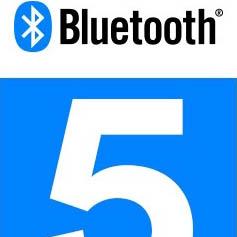
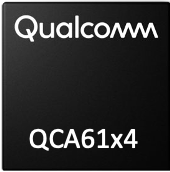


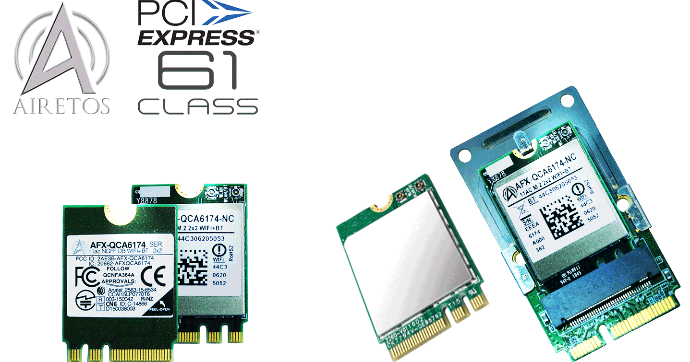













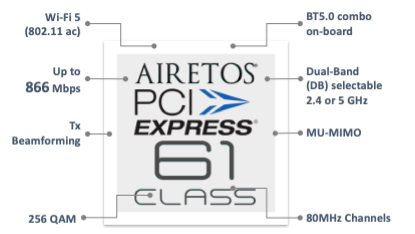
 .
.